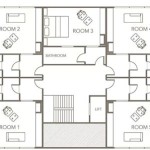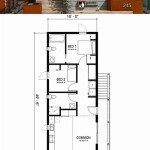
Floor plans for small living rooms are diagrams indicating the arrangement and dimensions of furniture, fixtures, and other elements within a limited spatial area. They serve as a blueprint for maximizing space utilization, ensuring efficient movement, and creating a comfortable and functional living environment. For instance, in a living room measuring 10 feet by 12 feet, a floor plan might outline the placement of a sofa, an armchair, a coffee table, and a bookshelf, optimizing the flow of traffic and optimizing the utilization of natural light.
Designing floor plans for small living rooms requires careful consideration of scale, functionality, and aesthetics. By adhering to principles of space planning and incorporating clever design techniques, homeowners can transform even the most compact living spaces into inviting and livable havens.
In this article, we will delve into the key elements of floor plans for small living rooms, exploring various layout options, space-saving strategies, and tips for creating a cohesive and stylish design. We will also provide practical examples and illustrations to guide readers in crafting their own optimized floor plans, empowering them to maximize the potential of their limited living spaces.
When designing floor plans for small living rooms, consider these 10 important points to optimize space and create a comfortable and stylish living environment:
- Maximize natural light
- Choose multifunctional furniture
- Utilize vertical space
- Create focal points
- Use mirrors to expand space
- Declutter and minimize belongings
- Incorporate smart storage solutions
- Consider an open floor plan
- Use rugs to define areas
- Accessorize wisely
By following these guidelines, you can create a floor plan that transforms your small living room into a functional, inviting, and stylish space.
Maximize natural light
Natural light can make a small living room feel larger and more inviting. There are several ways to maximize natural light in your floor plan:
1. Place furniture away from windows: Avoid blocking windows with furniture, as this will obstruct natural light. Instead, position your sofa, chairs, and other furniture pieces away from windows to allow light to flow freely into the room.
2. Use sheer curtains or blinds: Heavy curtains or drapes can block out natural light. Opt for sheer curtains or blinds that allow light to filter through while still providing privacy. You can also use blinds to control the amount of light that enters the room.
3. Use light-colored paint and dcor: Dark colors absorb light, making a room feel smaller and darker. Instead, use light-colored paint and dcor to reflect light and make your living room feel more spacious and airy.
4. Add mirrors: Mirrors can reflect light and make a room feel larger. Place mirrors opposite windows or in areas with limited natural light to bounce light around the room.
By following these tips, you can maximize natural light in your small living room, creating a more inviting and spacious living space.
Choose multifunctional furniture
Multifunctional furniture is a great way to save space and maximize functionality in a small living room. Here are four examples of multifunctional furniture that can help you make the most of your space:
- Sofa bed: A sofa bed is a great way to add extra sleeping space to your living room without taking up too much room. When you have guests over, simply pull out the bed and you have a comfortable place for them to sleep. When you’re not using the bed, it can be folded up into a sofa, giving you more space to move around.
- Ottoman with storage: An ottoman with storage is a great way to add extra seating and storage to your living room. You can use the ottoman to store blankets, pillows, and other items, freeing up space in your closets and cabinets. Some ottomans even come with built-in trays that can be used for serving drinks or snacks.
- Coffee table with drawers: A coffee table with drawers is a great way to add extra storage to your living room without taking up too much space. You can use the drawers to store books, magazines, and other items, keeping your living room tidy and organized.
- Nesting tables: Nesting tables are a great way to add extra surface space to your living room when you need it, and then tuck them away when you don’t. Nesting tables can be used for a variety of purposes, such as serving drinks, displaying books, or holding plants.
By choosing multifunctional furniture, you can save space and maximize functionality in your small living room. These versatile pieces of furniture can help you create a more comfortable and inviting living space that meets all of your needs.
Utilize vertical space
One of the best ways to save space in a small living room is to utilize vertical space. By using tall furniture and storage solutions, you can maximize storage and create the illusion of a larger room.
- Use tall bookcases and shelves: Tall bookcases and shelves are a great way to add storage to your living room without taking up too much floor space. You can use them to store books, movies, games, and other items. Some tall bookcases even come with built-in drawers or cabinets for additional storage.
- Hang floating shelves: Floating shelves are a great way to add storage and display space to your living room without taking up any floor space. You can use them to store books, plants, artwork, and other items. Floating shelves are also a great way to create a focal point in your living room.
- Use stackable bins and baskets: Stackable bins and baskets are a great way to maximize storage space in your living room. You can use them to store blankets, pillows, toys, and other items. Stackable bins and baskets are also a great way to keep your living room tidy and organized.
- Hang curtains from the ceiling: Hanging curtains from the ceiling is a great way to make your living room feel taller and more spacious. Curtains hung from the ceiling will also block out more light, which can help to create a more intimate and cozy atmosphere.
By utilizing vertical space, you can save space and create the illusion of a larger living room. These tips will help you make the most of your small living space.
Create focal points
A focal point is an object or area in a room that draws the eye and creates a sense of interest. In a small living room, it is important to create a focal point to help define the space and make it feel more inviting. There are several ways to create a focal point in a small living room:
- Use a statement piece of furniture: A statement piece of furniture is a piece of furniture that is unique and eye-catching. It could be a brightly colored sofa, a patterned armchair, or a sculptural coffee table. Placing a statement piece of furniture in your living room will instantly create a focal point and draw the eye.
- Hang a piece of artwork: A large piece of artwork can also create a focal point in a small living room. Choose a piece of artwork that you love and that reflects your personal style. You can hang the artwork above your sofa, fireplace, or any other focal point in the room.
- Create a gallery wall: A gallery wall is a collection of smaller pieces of artwork hung together on a wall. Gallery walls can be a great way to add personality to a small living room and create a focal point. You can use a variety of different frames and sizes of artwork to create a unique and eye-catching display.
- Use a rug to define a space: A rug can be used to define a specific area in your living room, such as the seating area or the dining area. Choose a rug that is large enough to ground the furniture in the space and create a sense of intimacy. You can also use a rug to add color and pattern to your living room.
By creating a focal point in your small living room, you can help to define the space and make it feel more inviting. These tips will help you create a focal point that reflects your personal style and makes your living room a space you love to spend time in.
Use mirrors to expand space
Mirrors are a great way to make a small living room feel larger and more spacious. By reflecting light and creating the illusion of more space, mirrors can help to open up a small room and make it feel more inviting. There are several ways to use mirrors to expand space in a small living room:
- Hang a large mirror on a wall: A large mirror hung on a wall can instantly make a small living room feel larger. The mirror will reflect the light and create the illusion of more space. You can hang a mirror above your sofa, fireplace, or any other focal point in the room.
- Place a mirror opposite a window: Placing a mirror opposite a window will reflect the light coming in from the window and make the room feel brighter and more spacious. You can place a mirror opposite a window in your living room, dining room, or any other room in your home.
- Use mirrors to create a gallery wall: A gallery wall is a collection of smaller mirrors hung together on a wall. Gallery walls can be a great way to add personality to a small living room and make it feel more spacious. You can use a variety of different frames and sizes of mirrors to create a unique and eye-catching display.
- Use mirrored furniture: Mirrored furniture is a great way to add extra storage and style to a small living room. Mirrored furniture will reflect the light and make the room feel larger. You can find mirrored coffee tables, end tables, and even sofas.
By using mirrors to expand space, you can make your small living room feel larger and more inviting. These tips will help you create a more spacious and stylish living space that you love to spend time in.
Declutter and minimize belongings
Clutter can make a small living room feel even smaller and more cramped. By decluttering and minimizing your belongings, you can create a more spacious and inviting living space. Here are some tips for decluttering and minimizing your belongings:
1. Get rid of anything you don’t use or need: The first step to decluttering is to get rid of anything you don’t use or need. This includes clothes you don’t wear, furniture you don’t use, and anything else that is just taking up space. Be ruthless and don’t be afraid to let go of things that you don’t need.
2. Donate or sell items you don’t use: If you can’t bring yourself to throw something away, consider donating it to charity or selling it online. This will help to get rid of clutter and make some extra money at the same time.
3. Store items you don’t use regularly: If you have items that you don’t use regularly, but you don’t want to get rid of them, consider storing them in a closet, attic, or basement. This will help to free up space in your living room and make it feel more spacious.
4. Use storage solutions to maximize space: There are a variety of storage solutions that can help you to maximize space in your living room. These include baskets, bins, shelves, and drawers. Use these storage solutions to store items that you don’t use regularly, as well as items that you need to keep within reach.
By decluttering and minimizing your belongings, you can create a more spacious and inviting living room. These tips will help you to get rid of clutter and make the most of your small living space.
Incorporate smart storage solutions
Smart storage solutions can help you to maximize space in your small living room and keep it organized. Here are four smart storage solutions that you can use in your small living room:
- Use built-in storage: Built-in storage is a great way to add extra storage to your living room without taking up any floor space. Built-in storage can include shelves, cabinets, and drawers. You can use built-in storage to store books, movies, games, and other items.
- Use furniture with storage: Furniture with storage is a great way to add extra storage to your living room without sacrificing style. Furniture with storage can include ottomans with storage, coffee tables with drawers, and beds with built-in drawers. You can use furniture with storage to store blankets, pillows, toys, and other items.
- Use vertical storage: Vertical storage is a great way to maximize space in a small living room. Vertical storage can include shelves, cabinets, and drawers that are mounted on the wall. You can use vertical storage to store books, movies, games, and other items.
- Use multi-purpose storage: Multi-purpose storage is a great way to maximize space in a small living room. Multi-purpose storage can include baskets, bins, and boxes that can be used to store a variety of items. You can use multi-purpose storage to store blankets, pillows, toys, and other items.
By incorporating smart storage solutions into your small living room, you can maximize space and keep it organized. These tips will help you to create a more functional and inviting living space.
Consider an open floor plan
An open floor plan is a great way to make a small living room feel larger and more spacious. By removing walls and barriers, an open floor plan creates a more fluid and cohesive space that allows light to flow freely and makes it easier to move around. There are several benefits to consider when adopting an open floor plan for a small living room:
1. Increased space and light: By removing walls and barriers, an open floor plan creates a more spacious and airy living room. Natural light can flow more easily through the space, making it feel brighter and more inviting. An open floor plan also makes it easier to move around the room, as there are no walls or barriers to obstruct your path.
2. Improved flow and functionality: An open floor plan allows for a more flexible and functional living space. You can easily rearrange furniture to create different seating areas or to accommodate different activities. An open floor plan also makes it easier to entertain guests, as you can easily move around the room and interact with your guests.
3. Increased sense of community: An open floor plan can help to create a more sense of community within your home. By removing walls and barriers, you can create a space where family and friends can easily interact and spend time together. An open floor plan also makes it easier to keep an eye on children or pets, as you can see them from anywhere in the room.
4. Improved air quality: An open floor plan can help to improve air quality in your home. By allowing air to circulate more freely, an open floor plan can help to reduce the build-up of dust and allergens. An open floor plan also makes it easier to ventilate the room, as you can open windows and doors to let in fresh air.
Overall, an open floor plan is a great way to make a small living room feel larger, more spacious, and more inviting. By removing walls and barriers, you can create a more fluid and cohesive space that allows light to flow freely and makes it easier to move around. An open floor plan also offers several other benefits, such as improved flow and functionality, increased sense of community, and improved air quality.
Use rugs to define areas
Rugs can be used to define different areas in a small living room, such as the seating area, the dining area, or the play area. This can help to create a more organized and cohesive space. Rugs can also be used to add color and pattern to a room, and to make it feel more inviting.
- Create a focal point: A rug can be used to create a focal point in a small living room. Place a rug in the center of the room, or under a piece of furniture, to draw the eye and create a sense of interest. You can also use a rug to define the seating area, by placing it under the sofa and chairs.
- Define the dining area: If your small living room also serves as a dining area, you can use a rug to define the space. Place a rug under the dining table and chairs to create a more intimate and cohesive dining space. You can also use a rug to add a touch of color and pattern to the dining area.
- Create a play area: If you have children, you can use a rug to create a play area in the living room. Place a rug in a corner of the room, or in a spot that gets a lot of natural light, to create a dedicated space for your children to play. You can also use a rug to add a touch of color and fun to the play area.
- Add warmth and texture: Rugs can add warmth and texture to a small living room. Choose a rug with a soft, plush pile to create a cozy and inviting space. You can also use a rug to add a touch of color and pattern to the room.
By using rugs to define areas in your small living room, you can create a more organized, cohesive, and inviting space. Rugs can also be used to add color, pattern, and warmth to the room.
Accessorize wisely
Accessories can add personality and style to a small living room. However, it is important to accessorize wisely to avoid making the room feel cluttered or overwhelming. Here are four tips for accessorizing a small living room:
- Choose a few key pieces: Instead of filling your living room with a lot of small accessories, choose a few key pieces that will make a statement. This could include a large piece of artwork, a unique lamp, or a statement rug. These pieces will help to add personality and style to your living room without making it feel cluttered.
- Use vertical space: Accessories don’t have to be placed on tables or shelves. You can also use vertical space to add interest to your living room. Hang artwork on the walls, or use floating shelves to display books and other objects. This will help to make your living room feel more spacious and inviting.
- Use mirrors to reflect light: Mirrors can be used to reflect light and make a small living room feel larger. Place mirrors opposite windows or in areas with limited natural light. This will help to brighten up the room and make it feel more spacious.
- Keep it personal: Your living room should reflect your personality and style. Choose accessories that you love and that make you feel happy. Don’t be afraid to mix and match different styles and colors. Your living room should be a space that you love to spend time in.
By accessorizing wisely, you can add personality and style to your small living room without making it feel cluttered or overwhelming. These tips will help you to create a space that is both stylish and inviting.









Related Posts








